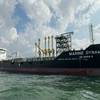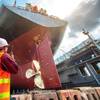There are a number of trends currently affecting the marine interior design field. First, vessels are being built larger with more numerous public spaces, each of which needs to have its own ambience while still maintaining common themes throughout the ship. This is particularly challenging in refurbishment work when only a portion of the existing spaces are upgraded, yet all spaces must flow together.
Second, new regulations must be understood and adhered to. This includes the regulatory interpretations of each of the Societies overseeing new construction and refurbishment.
Another developing trend ? particularly in the ferry and fast ferry markets ? is the need to reduce weight while maintaining serviceability.
In addition, the designer must look ahead and design to tomorrow's trends to maximize the return on investment for the owner. This includes developing a design that is often more complex and unusual while being both more practical to fabricate and then to install.
Finally, out of service times have steadily grown shorter in an effort to maximize revenues. These various factors have created a challenging environment within which the marine interior designer must work.
To effectively deal with these trends and the challenges they raise, Maritime Services Corp. (MSC) and its interior design department has moved towards a design/build concept for certain projects. The design/build concept is based on several assumptions, one of which is the premise that an owner can work more quickly, effectively and at lower overall cost with a single company providing both a world class interior design department, as well as the means to efficiently fabricate and install the finished product.
Lines of communication diminish as does decision and reaction times. Budgets are more realistic and easier to adhere to and the finished product will be more likely to reflect the desires and requirements of the owner. Surprises are all but eliminated. Should they arise, they are much easier to deal with in a timely fashion. Misunderstandings, miscommunications, omissions, duplications, deletions and other time and money wasters typical of contracts involving a number of entities each with their own agendas, are eliminated. Standardizing interior materials and fixtures on a fleet-wide basis reduces operating downtime and spares costs.
Safety of life at sea is the single greatest challenge faced by contemporary marine interior designers. Design elements must comply with regulatory requirements for safety of life at sea, be suitable for the marine environment, have a long service life, be easily maintained, and be stunning in their execution.
The number of products fitting these criteria are limited. Marine designers must be both talented and technically knowledgeable to be able to utilize these limited products in new and exciting ways.
Elements are developed to their limits, often appearing in various forms and finishes in designs which may reflect a turn of the century river boat or an ultra modern fast ferry. Color, fabrics, furniture, patterns, material and texture will often follow the trends of land-based design. MSC interior designers are currently using and exploring the use of new and existing materials as well as assisting suppliers and fabricators in the development of suitable new products.
Space planning and interior design aboard vessels have many things in common with land-based design work. Each must consider the psychology of colors and their affect mood, design spaces to appear larger and more inviting or smaller and more intimate, considering the demographics of each owner's target clientele. The creation of retail spaces, lounges, casinos and other revenue-enhancing spaces to invite spending are also important considerations.
Traffic patterns need to be considered and bottlenecks minimized. Food service, pantries and galleys need to be designed to quickly and efficiently prepare and serve several hundred or thousand meals at a single seating in facilities that also have to meet USPH and CDC requirements, the toughest of health standards. All of these concerns have to take into consideration the fact that ships ? even the larger, stabilized ones ? move about in the water, and this movement and its effect on passengers is of paramount importance to the overall design.
Each class of passenger vessel has particular design criteria specific to its intended service:
Dinner ship designs are based on the type of clientele the owner wants to attract, the method of food preparation and service and the conditions on the cruising grounds (i.e. weather and related factors and the competitive environment). In fact, this last factor is important in all design considerations for all ships regardless of their intended service.
Dinner ships may incorporate a lounge-type atmosphere for intimate conversations or larger open spaces for open dinning and dancing or both. Crystal Dolphin, owned and operated by Portland Spirit, Portland, Ore., a day and night cruise operator on the Willamette River, is an example of an MSC design build combining the intimate lounge with open dining spaces.
All surfaces were updated. The owners wanted more intimate, warm surroundings that allowed flexibility and multiple uses for their vessel. The owner elected to use the MSC design/build concept so they had to communicate with only one company to speed the project and control costs.
A palette of warm tones and sophisticated colors came in to play; a light terra cotta as the basis with the warmth of purples and copper added. A dark green carpet and navy blue accents were added to give the interior a classic lounge look. The hard materials used also added to the look of elegance; English brown granite and a mid-tone cherry wood were used throughout.
The main deck is used for dining/banquet/corporate functions and was designed to easily change the layout as needed. The second deck is an elegant lounge and bar area which has a fixed in layout with spaces to stimulate conversation and highlight the city views the Portland Spirit cruise offers.
Small cruise ships, like large ones, are concerned about the comfort and entertainment of their passengers. Smaller, more intimate vessels cater to a niche market comprised of a more sophisticated crowd eager to learn about the surroundings they are visiting. Competition among operators is focused on the vessels and their amenities. Itineraries vary month to month and climate to climate.
The ship's interior design must take into account these numerous variables. The typical small cruise customer requires retrofitted cruise ships have upgraded interiors in line with the standards they have come to expect. These requirements can be challenging to marine interior designers because of the inherent limitations of a smaller vessel.
Casino vessels look for a theme to inspire their interiors. It may be based upon a period in history or based upon a place we all aspire to be:
Ambassador II, owned and operated by Sterling Casino line, is Florida's largest offshore casino vessel. The vessel was previously a car/accommodation ferry based in Europe. Sterling Casino Line chose to have the conversion from ferry to casino ship done at A & P Tyne shipyard, Newcastle, England.
The client decided to bring in the MSC design and construction team for the project. MSC's design team took the design from conceptual sketches to final construction.
A complete set of construction drawings were created and then used to outfit the interior to include ceiling and lighting installation, plumbing, wiring, bulkhead construction, carpet design and installation, wall and column details, etc. The result was a successful design and build project.
The interior layouts are comfortable and spacious. There are four large casinos on 2 decks with 15-ft. ceiling heights and large ceiling domes with brilliantly painted sunsets to create a feeling of grandeur. There is elaborate wall decoration, cage and bar cabinetry, as well as beautifully designed carpets conveying a sense of the Art Deco period that inspired the design.
The color scheme of the ship's interior adds to the ambiance and theme. Pastel hues of sage green, periwinkle, and a warm cream tone are contrasted against black and mixed metals of brass, bronze, and silver. The scheme works successfully to add visual excitement to the vessel, which is important in casino spaces.
MSC added a fourth deck to Empress Casino Hammond (Empress III), in Hammond, Ind. MSC provided a deign/build package including all structural modifications. MSC designers had previously designed the three lower decks.
The primary goal was to complete the interior within nine months and not disturb the gaming patrons at any time during the construction. The owner wanted a theme similar to that of the three decks below, but with more architectural detail. This was not easy due to the low overheads but was accomplished.
Design/build is particularly applicable to the retrofitting of large cruise ships and is definitely more challenging than new construction. Short dock periods are common and often overseas under less than ideal situations.
Tight control of design, component prefabrication and construction are key to the successful completion of these projects, as is the coordination of owner supply with contractor supply materials. As noted above the creation of a design for the refurbishment of a particular space so it blends with existing, unrefurbished spaces and the overall ambience of the ship is a primary design concern.
Company Profile
MSC's Marine Interior Design Department started 4.5 years ago to fill a void in marine outfitting for Design/Build contracting. The Design/Build concept allows faster project completion and greater control over project costs by having the same marine interior designers involved from the very beginning until the very end of a project.
In order to accomplish this, the interior designer and associated contractor need to be a part of the project team from the conception of the project. This organizational concept keeps communication to a minimum allowing the project to proceed in a more timely and efficient manner.
In response to the demand for faster paced projects MSC's Marine Interior Design Department has completed more than 26 Design /Build projects. Numerous other projects undertaken by MSC have benefited from the liaisons between the MSC design team and designers selected by the owner or shipyard. MSC currently has several design/build projects underway from Singapore to Lisbon for large cruise ship operators such as Holland America.
The department offers all aspects of marine interior design. The services encompass research, development, and implementation of plans and designs of quality marine interiors.
For optimum results the interior design process follows an organized and coordinated methodology: Research, analysis, information from the owner, and integration of the creative process from MSC's interior designer's result in a practical, functional and beautiful marine interior.
Sponsored Content
Empowering sustAInability: could NAVTOR innovations transform maritime operations?

Charting a Smarter Course: How Nautical Systems by ABS Wavesight is Powering the Future of Fleet Management

August 2025
 Read the Magazine
Read the Magazine

 Read the Magazine
Read the Magazine
This issue sponsored by:

Hidden Threats at America’s Ports: Why Foreign-Made Cranes Pose Strategic Risk
Subscribe for
Maritime Reporter E-News
Maritime Reporter E-News is the maritime industry's largest circulation and most authoritative ENews Service, delivered to your Email five times per week









